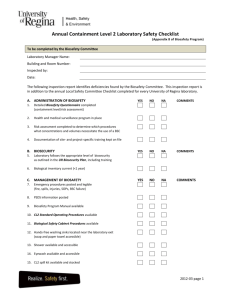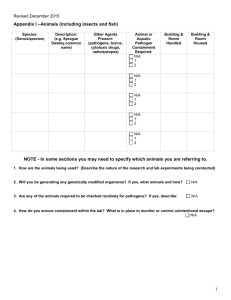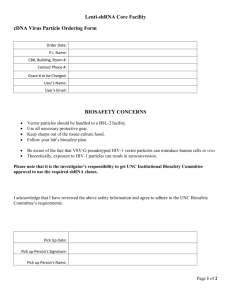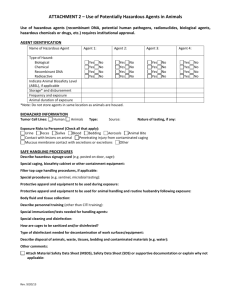Working with Human and Animal Cell Cultures
advertisement
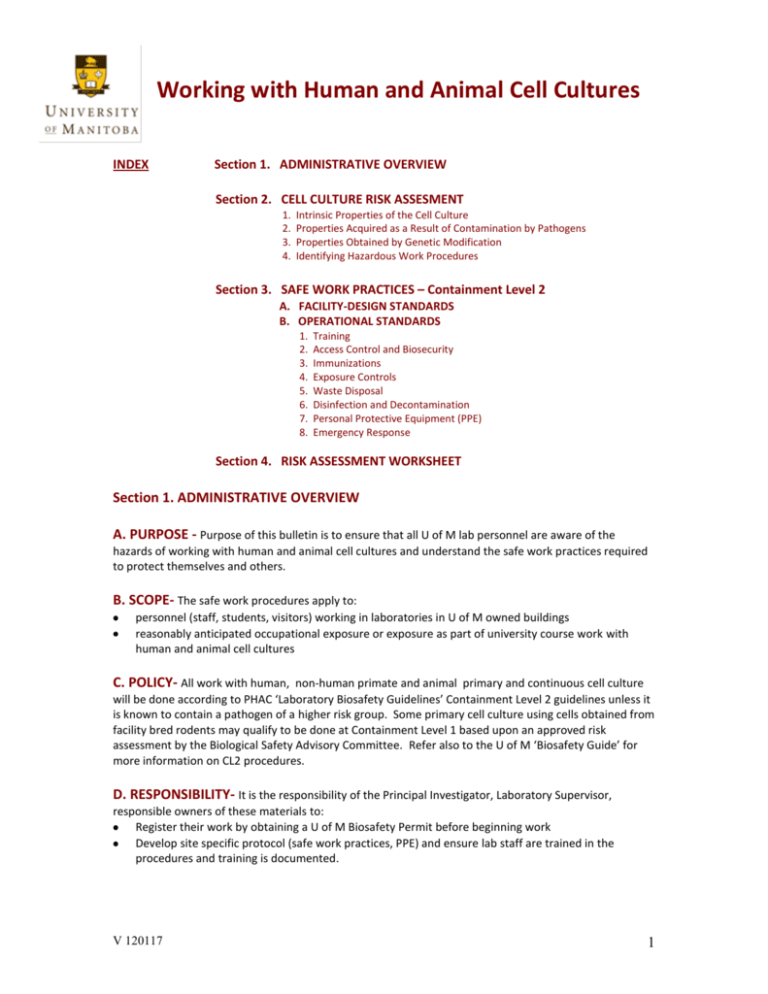
Working with Human and Animal Cell Cultures INDEX Section 1. ADMINISTRATIVE OVERVIEW Section 2. CELL CULTURE RISK ASSESMENT 1. 2. 3. 4. Intrinsic Properties of the Cell Culture Properties Acquired as a Result of Contamination by Pathogens Properties Obtained by Genetic Modification Identifying Hazardous Work Procedures Section 3. SAFE WORK PRACTICES – Containment Level 2 A. FACILITY-DESIGN STANDARDS B. OPERATIONAL STANDARDS 1. 2. 3. 4. 5. 6. 7. 8. Training Access Control and Biosecurity Immunizations Exposure Controls Waste Disposal Disinfection and Decontamination Personal Protective Equipment (PPE) Emergency Response Section 4. RISK ASSESSMENT WORKSHEET Section 1. ADMINISTRATIVE OVERVIEW A. PURPOSE - Purpose of this bulletin is to ensure that all U of M lab personnel are aware of the hazards of working with human and animal cell cultures and understand the safe work practices required to protect themselves and others. B. SCOPE- The safe work procedures apply to: personnel (staff, students, visitors) working in laboratories in U of M owned buildings reasonably anticipated occupational exposure or exposure as part of university course work with human and animal cell cultures C. POLICY- All work with human, non-human primate and animal primary and continuous cell culture will be done according to PHAC ‘Laboratory Biosafety Guidelines’ Containment Level 2 guidelines unless it is known to contain a pathogen of a higher risk group. Some primary cell culture using cells obtained from facility bred rodents may qualify to be done at Containment Level 1 based upon an approved risk assessment by the Biological Safety Advisory Committee. Refer also to the U of M ‘Biosafety Guide’ for more information on CL2 procedures. D. RESPONSIBILITY- It is the responsibility of the Principal Investigator, Laboratory Supervisor, responsible owners of these materials to: Register their work by obtaining a U of M Biosafety Permit before beginning work Develop site specific protocol (safe work practices, PPE) and ensure lab staff are trained in the procedures and training is documented. V 120117 1 Ensure staff are given the opportunity to protect themselves through immunizations (if available) as per the U of M Policy/Procedure: Immunization Standard and to document immunization and/or counselling. E. DEFINITIONS Cell Strain: Synonyms- primary cell line, finite cell lines, non-transformed cells These are cells propagated in vitro from primary explants of human or animal tissue or body fluids and which have a finite lifetime in tissue culture for approximately 20-70 passages. Cell Line: Synonyms- continuous cell line, transformed cells, immortalized cells. These are in vitro or animal-passaged (e.g. nude mouse) cultures or cells which are immortalized; having been obtained by isolating cells from tumours, mutating or transforming primary cells by spontaneous mutation or natural or laboratory infection with a mutagen or immortalizing agent like a virus or recombinant DNA . E.g. a virus like Epstein Barr virus (EBV). Hybridoma Cell Lines: These are produced by fusing a primary cell line to a continuous cell line. Section 2. CELL CULTURE RISK ASSESSMENT The intent of the risk assessment it to determine the Risk Group of any potential pathogens contained by the culture and is based on the following factors which are discussed in more detail below. Note that an accurate risk assessment depends on the use of authenticated cells. (1) intrinsic properties of the cell culture (2) potential for inadvertent or deliberate contamination with pathogens. (3) properties acquired as a result of genetic modificationAdditionally the risk assessment must include a review of the: - type of manipulation(s) to be done - ability to implement adequate safe work practices based on all of the above. The combination of all of these five items will lead the PI to determine the Containment Level required for his or her work and any other special precautionary practices. Containment Level requirements will follow the PHAC or CFIA Containment Level Facility Design and Operational Practices. 1. Intrinsic Properties of the Cell Culture (properties of the actual cells) 1.1 Species of origin The closer the genetic relationship to humans, the higher the risk is to humans. If from a nonprimate source, evaluate if the cell line is known to harbour or support the growth of zoonotic organisms. For example, the potential for a mouse cell line to contain or grow hantavirus or a human cell strain or cell line to potentially contain or grow avian influenza virus. Risk Order: Human & Non-Human Primate > Mammalian > Avian > Invertebrate Important Notes: The ability of non-immuno-compromised individuals to reject foreign material is an important aspect of personal safety when working with any cell cultures. V 120117 2 Procedures or experiments with transformed human cells derived from the operator are prohibited. i.e. Never handle autologous cells (cells isolated from the user) because these will express the tissue type of the operator and could evade the normal immune responses that recognize and destroy foreign cells. 1.2 Cell or tissue type Cells may habour endogenous viruses or may have tumourgenic potential and may present more risks of becoming or being fully neoplastic upon accidental or deliberate introduction into the human body. Risk Order: based on cell type and tumour-inducing potential: Hematopoietic Cells > Neural Tissue> Endothelium> Gut Mucosa > Epithelial & Fibroblast Cells 1.3 Culture Type Primary cells are obtained directly from fresh tissues and should first be assessed for risk based on the pathogen-carrying status of the animal species of origin and cell or tissue type. However, the time available for characterization and detection of inherent contaminating agents remains limited because of their shorter life span and increasing risks resulting from repeatedly obtaining them from fresh tissue. For example, if human, the donor(s)’ health status needs to be considered; if animal, the species and whether the animals are captured in the wild or facility bred or SPF( specific pathogen free) needs to be considered. See also the discussion below on contaminating agents. Risk Order: based on culture type: Primary Cells > Continuous Cell Lines > Well-Characterized Cell Lines 2. Properties Acquired as a Result of Contamination by Pathogens 2.1 Adventitious contaminating agents The main risk in tissue culture work is the contamination of cultures with adventitious agents such as bacteria, fungi, mycoplasma, viruses and prions. There are documented cases of laboratory workers infected with these while handling cell cultures. Bacteria and fungi are immediately apparent because they overgrow the cells. The use of antimicrobials may alter cell characteristics, lead to resistant strains of microorganisms or not totally eradicate these contaminants. Mycoplasma and viruses may not be readily detected. Mycoplasma is one of the most common cell culture contaminants and may go undetected unless you test for it. There is also evidence that applying various treatments might lead to induction of latent viruses (endogenous or adventitious). Such procedures include change in pH, serum level, temperature, medium supplements and co-cultivation. Prions have been shown to be hosted by some neural cultures and recent reports indicate that a broader range of cells can support prions. Sources of potential contamination are generally considered to be: 1. the organ/organism from which the cell culture was established V 120117 3 First assess for risk based on the pathogen-carrying status of the animal species of origin and cell or tissue type. Review the SWP for handling human blood, body fluids and tissue for further discussion of the contaminants of primary human material. Cells of non-human origin may have less risk, however, many viruses may have a broader host range and can cross species barriers. See Table 1 in the Reference #1, for a list of viral contaminants of animal cell cultures or tissues that can cause human disease. 2. a component of animal origin in the cell culture medium For example prions and viruses associated with bovine-derived products. It is important to question your serum sources regarding the procedures that they have in place to minimize these risks. 3. an infection unintentionally introduced during handling. Because of the nutrient rich nature of modern tissue-culture media, aseptic technique must be used at all times. Most cultivation work is now done in the BSC. This protects the worker and assists in reducing the contamination of cultures by providing a sterile work area. Since the nature of an infecting pathogen is usually unknown, it is recommended to work at Containment Level 2 and autoclave and dispose of any contaminated cultures and only work with one tissue culture type in the BSC at one time. ATCC categorizes the safety level of cell lines based upon known pathogenic agents only. For example, HeLa cells carrying HPV or cells known to be transformed by a pathogenic virus. ATCC does NOT routinely consider the potential for cells to be contaminated by adventitious micro-organisms when assigning the safety level. Cells are only screened for adventitious agents when indicated. Human cell lines are not routinely screened for HIV, Hep B or C. 2.2 Deliberate infection of cell cultures Examples of procedures that would use the deliberate infection of cell cultures include: using a virus to transform a primary cell line to generate an immortalized cell line, maintenance of viral cultures and stocks, study of pathogen life cycle pertinent to infection or oncogenicity, clinical determination of patient disease or as vectors for rDNA studies. Where the intended work includes the deliberate infection of a cell line, the work must be done at the highest containment level of the combined system and intended procedures. An MSDS is required for all Risk Group 2 and greater microorganisms. 3. Properties Obtained by Genetic Modification Risk assessment for recombinant systems includes the careful evaluation of the characteristics of the host cell line, the material to be inserted into the cell line and the vector used for the insertion. The work must be done at the highest containment level of the combined system and intended procedures. An MSDS is required for all Risk Group and greater microorganisms. For a more complete discussion of this topic refer to the section on rDNA in the Biosafety Guide. V 120117 4 From Ref. 1 ‘….Particular attention should be paid to the use of packaging cell lines. These are established cell lines which are deliberately and stably transfected with “helper constructs” to ensure the production of viral vectors. For example, in case of retroviral packaging cell lines, the expression of “helper genes” allows high-level constitutive production of viral proteins which are missing in the genome of the viral vector but are crucial for viral replication. One of the most important biosafety issues related to the use of packaging cell lines is the fact that replication competent viruses may be generated as a result of (homologous) recombination following transfection with viral vectors. ………endogenous retroviral packaging cell lines may still give rise to unwanted recombination events. This means that the possibility of replication competent viruses is never completely ruled out…..Consequently risk assessment of the packaging cell lines should be based on the biosafety of the produced viral vectors, including an evaluation of their infectivity, spectrum of host range, capacity of integration (insertional mutagenisis) stability and physiological role of the insert if expressed.’ 4. Identifying Hazardous Work Procedures As in all work with biological agents, a risk assessment involves the evaluation of procedures to identify those processes that will increase the risk of transmission by ingestion, respiration, auto-inoculation, splashes to mucous membranes and broken skin. A further discussion of this can be found in Section 4.1. For work with human cell lines also review the pertinent sections in the Biosafety Guide Appendix 6: Working with Human Blood, Tissue and Body Fluids . Additionally consider that altering culture conditions by changing the availability of cell nutrients or co-culturing may alter cell-surface characteristic, release endogenous viruses, alter neoplasia or susceptibility to viruses and require that the risk assessment be re-evaluated. Since most cell culture work is initially done in a BSC, the hazard due to some of these is reduced by the engineering controls of the cabinet. Special consideration must then be taken when procedures are outside of the BSC. Where the experimental protocols involve treating the cells with a chemical agent or fixative that is known to kill the cells and any pathogens that they may contain, the work can be considered as no longer being a biohazard and is safe to continue on the open bench. When working outside of the BSC and the cells have not been fixed or killed, evaluate for aerosol generating procedures. At Containment Level 2 all aerosol producing procedures must be done inside the BSC. Special hazards exist for flow cytometry and cell sorting, where the use of a fixative may not be appropriate. For a discussion of the safety consideration in these circumstances, refer to the recommendations approved by the Society of Analytical Cytology. For work with cell cultures in animal studies, the hazardous work procedures are generally considered to be self-inoculation and exposure to aerosols and are reviewed through the animal care program. 4.1 Hazardous Work Procedures described by potential routes of transmission of bioagents 4.1.1 Accidental puncture by a contaminated sharp object. In the lab examples of such tasks could include, using needles/syringes, razor blades, glass tubing, pipettes, pipetteman tips, handling waste and trash. V 120117 5 4.1.2 Contamination of skin and mucous membranes: Direct contact with contaminated material through open cuts or skin abrasions, or to mucous membranes (e.g. unprotected mouth, eyes, nose) through unanticipated splashes, e.g. opening tubes of uneven pressure, tubes, bottles breaking releasing liquid hitting a hard surface. Indirect transmission to open cuts or mucous membranes ( eyes, mouth, nose, genitals) through transfer by hand/glove contact of unknowingly contaminated surfaces. i.e. created by splashes or aerosols that land at a distance from the source procedure. 4.1.3 Ingestion Exposure could be due to direct contact or indirect contact with the material by the following actions. unconscious hand-to-mouth actions placing contaminated articles or fingers in the mouth eating, drinking or smoking in the laboratory or failing to use proper hand hygiene mouth pipetting 4.1.4 Inhalation Exposure could due to breathing in aerosols unknowingly generated by aerosol producing procedures with the sample material. For example, sonicating or vigorous pipetting. Some surveys indicate that up to 80% of laboratory acquired infections were transmitted by aerosols. At Containment level 2 all aerosol producing procedures should be done in the BSC. Section 3. SAFE WORK PRACTICES -Containment Level 2 Requirements FACILITY DESIGN STANDARDS Refer to Section 7.1.3 in the U of M Biosafety Guide or Chapter 4 of the Laboratory Biosafety Guidelines for all Containment Level 2 facility design standards. OPERATIONAL STANDARDS NOTE: 1) The following are specific Containment Level 2 operational requirements for cell culture work. Refer to Section 7.1.3 in the U of M Biosafety Guide or Chapter 4 of the Laboratory Biosafety Guidelines for an overview of PHAC general the requirements. 2) Until inactivated, all of the following operational standards apply. Inactivation may include disinfection or decontamination steps (e.g. autoclaving or surface disinfection with 70% EtOH) or another chemical or heat inactivation that is part of the experimental procedure. The chemical or heat inactivation must be validated by the PI. 1. Training a. V 120117 PI is to provide training on this SWP, First aid and Post Exposure Protocol. 6 b. c. PI is to identify the location of spill control material and safety equipment including eyewash and shower available on-site. All personnel must be trained in the Safe Work practices or supervised. 2. Access Control and Biosecurity a. Doors to laboratories where the work is done must not be left open b. Restrict entry to laboratory staff, animal handlers, maintenance staff and others on official business. c. A U of M WHIP sign is required with appropriate contact info, Containment level 2 and biohazard logo. d. Refer to Basic Lab Biosecurity Plan in the Biosafety Guide. 3. Immunization a. Safe Work Practices and immediate exposure follow-up are the main factors in protecting workers from all potential exposures. b. Additionally all workers should consult with their personal health care provider to ensure that their general immunization status meets with current Manitoba Health/Canadian Immunization Guidelines. HBV immunizations are not currently broadly provided to Manitobans. Following are the requirements for all workers with occupational exposure to human and nonhuman primate cell lines at the U of M. If you need assistance please contact the EHSO Occupational Health Coordinator at 474-6438. Hepatitis B For occupational exposure at the U of M, the PI/Departments/responsible owners of these materials will ensure that: All current and new lab personnel working with human and non-human primate cell lines should be advised of the hazard and given the opportunity to protect themselves with Hep B vaccinations as per the U of M Procedure: Immunization Standard . 4. Exposure Control a. Working inside a BSC is advised. Since most cell culture work is initially done in a BSC, the hazard due to aerosol producing procedures and splashes of these is reduced by the engineering controls of the cabinet. b. If your risk assessment indicates bench work is acceptable ( i.e no aerosol producing or large volume procedures) special consideration must still be taken when procedures are outside of the BSC. Take care to avoid spilling and splashing infected and address sharps and needle hazards. Consider if working behind a shield and additionally wearing eye and/or face protection would be beneficial. c. Other precautions are similar to standard and CL2 operational requirements: 4.1 To avoid transmission by Direct Contact a. Wear the Personal Protective Equipment (PPE) prescribed in the document or by your PI. b. Wear Gloves (e.g., latex, vinyl, co-polymer) for all procedures that might involve direct skin contact with potentially infectious material. c. Keep hands away from the eyes, nose and mouth in order to avoid potential exposure of the mucous membranes. V 120117 7 Hand washing is a critical component of exposure control. Wash your hands after gloves have been removed, before leaving the laboratory and at any time after handling materials known or suspected to be contaminated. e. Cover open wounds, cuts, scratches and grazes with waterproof dressings and gloves. If you are exhibiting any open skin in areas that can not be covered by dressings or clothing, re-evaluate the work process. Suggestions include for example, if the open wound is on the face, to work with a full face shield, work in the BSC or having someone else do the work. f. Do not eat, drink, smoke, store food, personal belongings, or utensils in the lab. g. Do not apply cosmetics, insert or remove contact lenses. Wearing contact lenses is permitted only when other forms of corrective eyewear are not suitable. h. Wearing jewellery is not recommended in the laboratory. For example, large rings can puncture gloves, watches and necklaces can hang in your cultures. i. Oral pipetting of any substance is prohibited in any laboratory. j. Tie back or restrain long hair so that it cannot come into contact with hands, specimens, containers or equipment. d. 4.2 To avoid exposure by accidental puncture a. Strictly limit the use of needles, syringes and other sharp objects. Avoid autoinoculation and the generation of aerosols during use and disposal. a. Promptly place in a puncture-resistant sharps container. b. Do not bend, shear, recapp or remove from the syringe. b. Safety-Engineered sharps should be used in research labs whenever suitable for the task. c. Replace glass with plastic where possible. Replace procedures using needles, scalpel blades, with alternate less hazardous tools where possible. d. Identify and develop site-specific waste disposal protocol for all sharps that may come in contact with cell lines. The protocol must comply with the U of M Biohazardous Waste Chart.and Biosafety Guide waste disposal requirements. e. Fill sharps containers only 2/3s full. 4.3 To avoid accidental exposure by indirect transmission a. Separate paperwork and report writing from biohazardous materials work areas. b. Clean and decontaminate work surfaces with a suitable disinfectant at the end of the day and after any spill of potentially biohazardous material. c. Do not wear protective laboratory clothing in non-laboratory areas d. Do not store laboratory clothing in contact with street clothing. e. Decontaminate and label or tag-out contaminated materials and equipment leaving the laboratory for servicing or disposal. Follow U of M Decommissioning Procedure and Standards of Care for Decommissioning Guidance Document, and Biohazardous Waste Chart. 5. Biohazarodus Waste Disposal a. 6. Follow the U of M Biohazardous waste disposal guidelines and Chart. Disinfection and Decontamination a. Use disinfectants effective against the agents. These must be available at all times within the areas where the biohazardous material is handled or stored. b. Refer to the MSDSs for other acceptable disinfectants for agents which are known contaminants of any cell line. E.g. for HBV and HIV. V 120117 8 c. Refer to Section 8.5 in the U of M Biosafety Guide for selection of appropriate concentrations and use of bleach and alcohol in. Note the short shelf life for bleach. Working solutions should be made fresh weekly. Bleach is corrosive on stainless steel. If your are using it in the BSC follow with a rinse with water and then 70% Ethanol. 7. PPE Wear the PPE as prescribed by your PI or as found below. Refer also to Biosafety Guide . 7.1 Shoes a. Wear close toed and heel shoes in the lab at all times. 7.2 Lab coats a. A clean lab coat for changing should be available at all times. b. No bare legs and arms are preferred. i.e. long pants & socks, lab coat with long sleeves with cuffs and buttoned up. c. If a known or suspected exposure occurs to any clothing, decontaminate clothing before laundering E.g. autoclaving lab coats or treating spill with bleach. (unless laundering facilities are within the containment laboratory and have been proven to be effective in decontamination). d. A back closing gown may be preferred or be required for some work. E.g. Work in a BSC depending on the specific hazards of your cell line, spill clean-up. 7.3 Face Protection a. Wear safety glasses for all bench work with the biological materials. b. For spill clean up outside of the BSC wear face protection (full face shield or safety glasses and mask). 7.4 Gloves: a. Wear gloves (e.g., latex, vinyl, co-polymer) for all procedures that might involve direct skin contact with potentially infectious material. b. Inspect gloves for tears and punctures before putting them on. c. Have gloves available in sizes required by lab personnel. Nitrile is preferred due to fewer allergy issues. Nitrile gloves will not maintain their integrity when punctured, thus identifying a potential exposure sooner. d. Do not touch contaminated surfaces with bare hands when removing your gloves. e. Wash your hands immediately after removing gloves. f. Remove your gloves when leaving the laboratory and before touching clean surfaces in the lab like phones, computer, light switch, door handles and reference books. g. Decontaminate your gloves with other laboratory wastes before disposal. h. Wear gloves if you have dermatitis or other lesions on the hands and you have indirect contact with potentially infectious material. 8 Emergency Response 8.1 Post Exposure Protocol a. Post the -Post Exposure Protocol (PEP) for your campus in the lab. The PEP is available on EHSO Biosafety Program web-site. V 120117 9 8.2 First Aid If a known or suspected exposure occurs to: a. Eyes and other mucous membranes or non-intact skin- wash the areas and follow the PEP. Seek medical assistance within two hours. Take along the U of M Post Exposure Protocol , any available MSDS or lab specific information if available, any remaining sample involved in the exposure if available. b. Any small intact areas of skin: initiate first aid by washing skin surfaces thoroughly and immediately with soap and water. c. Large skin areas: activate the emergency shower. d. Eyes: use the eye wash. 8.1 Spill Clean-up Refer to the Biohazardous Spill Clean-up Posters in the Biosafety Guide Appendix 13 and 14 called Biohazardous Spill Response and General Biohazardous Spill Clean-up Poster. a. Have suitable disinfectants available in the lab at all times. b. Wear all the stated PPE including double gloves and full shoes and cover your legs. In addition, wear a back-closing gown and full-face protection when cleaning up any large spills of human tissue or fluids or their extracts, or when splashes or sprays of the materials are possible. c. Pick up contaminated broken glassware using a brush and dustpan, tongs or forceps. d. Move carefully during spill clean-up to avoid splashes and/or self-contamination. e. If a known or suspected exposure occurs to any clothing, treat that item as contaminated. It must be decontaminated before laundering, for example by autoclaving lab coats or treating a spill with bleach. This is true unless laundry facilities are available inside the containment lab and have been proven as effective in decontamination of fabric. f. Report spills, accidents or exposures as soon as possible to the laboratory supervisor/PI. A written record of such incidents must be maintained, and the results of incident investigations should be used for continuing education. Other Resources and links Sigma Aldrcih Fundamental Techniques in Cell Culture …A Laboratory Handbook http://www.sigmaaldrich.com/life-science/cell-culture/learning-center/ecacc-handbook.html Swiss guidelines on Cell Cultures http://www.uoguelph.ca/ehs/uploads/2010/08/swiss-guidelines-on-cell-culture.pdf http://www.uoguelph.ca/ehs/uploads/2011/01/ecvam-guidance-doc-cell-culture1.pdf Corning cell culture guidelines http://ems3.intellor.com/index.cgi?c=105&t=13&s=corningweb Cell Line cross contamination http://onlinelibrary.wiley.com/doi/10.1002/ijc.23567/pdf V 120117 10 Cell Culture Risk Assessment Worksheet A. Pathogen Risk Assessment 1. Cell Culture/Line Name : 2. Cell Type : ___________________________________________ Primary [ ] Established/Continuous [ ] Hybridoma Cell line [ ] 3. Species of Origin: Human [ ] Other 4. Organ/ Tissue: Non-human primate [ ] [ ] Name:_______________________ _____________________________________ 5. Obtained From Commercial source: e.g. ATCC ____________________ Catalogue Number _____ ______________ Other : e.g. Dr. X at U of ABC ____________________ Transformed? Yes No If yes – specify e.g. chemical, oncogene, human oncogenic virus __________________ 6. Has the cell line been verified? If yes, how, who, what … Yes No Don’t Know 7. Is the cell culture is known to be infected with a pathogen or any characterized agents? Yes No Don’t Know If yes – Name _______________________ Risk Group 1 2 3 (circle one) Is an MSDS available for the pathogen(s)? Yes If yes, then also review the specific pathogen risk assessment checklist. No Yes No Is a vaccine available for the identified pathogen ? 8. Has the cell culture been tested for any potential pathogens? Yes No 9. Are toxins or viral particles actively secreted? ( E.g EBV) If yes name_____________________ Don’t Know Yes No 10. Proposed Containment Level (check one one) . See Biosafety Guide Section 7.1.3.3 Containment Level: 2[ ] 2 enhanced[ ] 2+ [ ] 3[ ] V 120117 11 B. Personnel Risk Assessment 11. Have all lab personnel working with or near any of the above material received documented training as per this risk assessment as well as a program-specific training, describing the routes of exposure, signs/symptoms of disease, treatments, U of M Post Exposure Protocol and the requirement to report for medical attention if symptoms appear? Yes No C. Facility Design Compliance 12. Proposed Containment Level (check one). See Biosafety Guide Section 7.1.3.3 Containment Level: 2[ ] 2 enhanced[ ] 2+ [ ] 3[ ] 13. All work will be conducted at the proposed Containment Level Facility Design requirements as per the PHAC Laboratory Biosafety Guidelines and U of M Biosafety Guide? Yes No D. Operational Practices Risk Assessment Yes Yes 14. Will sharps be used? If YES, are you using safety engineered sharps? If not, explain: No No 15. If YES, do you have approved sharps containers (autoclavable, puncture resistant, secure lid) available for disposal? Yes No If not, explain sharps disposal procedure: 16. How and at what stage of the experiment is the infectious agent inactivated or lysed? OR What is the method of terminal inactivation? Yes 17. Will all work be done in a BSC? 18. Largest volume used: < 1Litres 1-10LItres >10Litres No (circle one) Typical Volumes, containers, concentrations used: _____________________________ 19. Disinfectants and decontaminants in use: ____________________________________ How is efficacy of the above determined? 20. All work is done in the BSC? Yes No 21. If bench work is done, identify procedures that would increase the hazard Aerosol producing procedures including cell sorting, sonication, centrifuging in open containers, shaking or vigorous mixing or pipetting. Blending grinding, opening containers whose internal pressures may be different from ambient pressure? Procedures that create a splash, spill hazard V 120117 12 OR 22. If bench work is done, describe measures to be used for the protection of personnel and the environment. How will the hazards be mitigated? How are the resulting aerosols controlled? 23. Will your experiments involve centrifugation? If yes, are sealed rotors, or sealed centrifuge safety cups available for use? Yes No 24. Will you open the tubes in the BSC after centrifuging? Yes No 25. Are any additional CL2 Operational Practices or safe work practices required? V 120117 13


